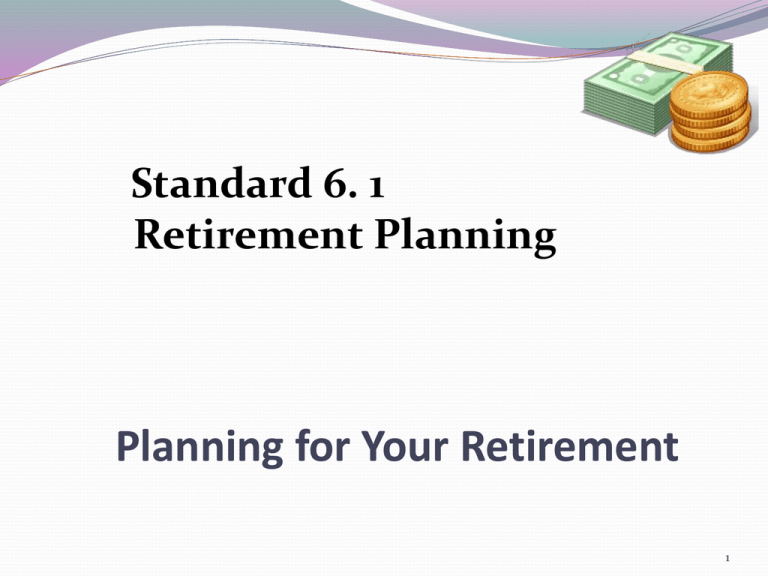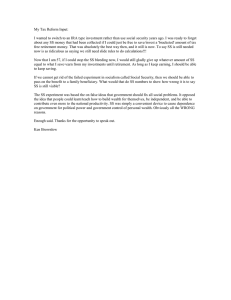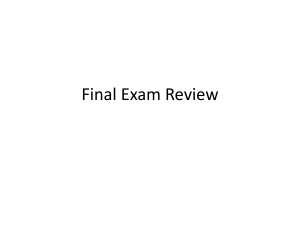
Standard 6. 1
Retirement Planning
Planning for Your Retirement
1
What is a Pension Plan
A systematic plan created and maintained to make
regular payments of benefits to retired or disabled
employees, either on a contributory or a
noncontributory basis.
2
Public Pension Plans
Public pension plans are established by:
States
Municipalities (cities, towns)
Social Security is a public pension plan
established by the United States government
in 1935.
3
Social Security
Social Security is:
Most common form of retirement benefit
Provided by the Federal Government
Supported with payroll taxes
One of the largest government programs in the world and
the greatest single expense in the Federal budget
Currently, the average social security check is only about
$1,000.
4
Social Security (Continued)
Benefits are based on the number of
years you work and income earned.
Not designed to be a sole source of
income, but supplemental income for
people over age 65 ( *age 62, 67, 70).
Develop savings and investment
strategies for a financially secure
retirement.
*Depending on different factors age may
vary.
5
Social Security
Social Security is an important source of
retirement income for many Americans.
The amount of Social Security retirement
benefits you receive is based on your earnings
over the years. Each year the Social Security
Administration will send you:
A history of your earnings
An estimate of your future monthly benefits
6
Other Public Pension Plans
The federal government provides other special retirement
plans for:
Federal government workers
Railroad employees
The Veterans Administration provides pensions for
survivors of people who died while serving in the armed
forces.
Also many state and local governments provide retirement
plans for their employees.
7
Employer Pension Plans
Another possible source of retirement
income is an employer pension plan.
Private employer pension plans vary. If the
company you work for offers one, find out:
What benefits you will receive
When you will become eligible to receive
those benefits
8
Defined-Contribution Plan
definedcontribution plan
an individual
retirement
account for each
employee
401(k) plan
a type of
retirement savings
plan funded by a
portion of your
salary that is
deducted from
your gross
paycheck and
placed in a special
account
With a defined-contribution plan, the employer
contributes a specific amount to the account
annually.
Several types of defined-contribution plans are:
Money-purchase plans – May be a
percentage of your earnings.
Stock bonus plans – Used to buy stock in the
company for you.
Profit-sharing plans – Depends on the
company’s profits each year.
401(k) plans (Most Common Type) –
invested in stocks, bonds, % mutual Funds.
403(b) plans – Tax-exempt institutions such
as a hospital or nonprofit organization.
9
401(k)
Most common type of
company retirement plan is a
401(k)
Two basic features:
Allows you and/or your
employer to put money in an
investment account each
month.
Tax-deferred = Taxes are not
due on the amount invested
until you withdraw the money.
10
401(k) - continued
Many young employees fail to see the
benefit of participating in a company
retirement plan.
Can be an expensive choice, particularly if
the employer matches the money you
place in the fund.
11
Vesting
vesting
the right of an
employee to keep
the company’s
contributions from
companysponsored plans,
even if the
employee no
longer works for
that employer
One of the most important aspects of
employer pension plans is vesting.
Vesting occurs at different points in time,
depending on company policy.
After a certain number of years with a
company, you become fully vested, or
entitled to receive 100 percent of the
company’s contributions to the plan on
your behalf.
12
Defined-Benefit Plan
defined-benefit
plan
a retirement plan
that specifies the
benefits an
employee will
receive at
retirement age,
based on total
earnings and years
on the job
A defined-benefit plan does not
specify how much the employer
must contribute each year.
Instead, your employer’s
contributions are based on how
much money the fund will need for
each participant in the plan who
retires.
13
Personal Retirement Plans
Many people choose to set up personal retirement
plans. Such plans are especially important to:
Self-employed people
Other workers who are not covered by
employer pension plans
Among the most popular personal retirement
plans are individual retirement accounts (IRAs)
and Keogh accounts.
14
Individual Retirement Accounts
individual
retirement
account (IRA)
a special account
in which a person
saves a portion of
income for
retirement
There are various types of IRAs, including:
Regular IRA
Roth IRA
Simplified Employee Pension (SEP) IRA
Spousal IRA
Rollover IRA
Education IRA
The biggest benefit of an IRA lies in its taxdeferred earnings growth.
15
Regular IRA
Tax-deferred interest and earnings
Annual limits on individual
contributions
Limited eligibility for tax-deductible
contributions
Contributions do not reduce current
taxes
16
Roth IRA
Tax-deferred interest and earnings
Annual limits on individual
contributions
Withdrawals are tax-free in specific
areas
Contributions do not reduce current
taxes
17
Simplified Employee Pension Plan
(SEP-IRA)
Tax-deferred interest and
earnings
“Pay Yourself First” payroll
reduction contributions
Pre-tax Contributions
18
Spousal IRA
Tax-deferred interest and earnings
Both working spouse and nonworking
spouse can contribute up to the annual
limit
Limited eligibility for tax-deductible
contributions
Contributions do not reduce current taxes
You have to file a Joint Return.
19
Rollover IRA
Traditional IRA that accepts
rollovers of all or a portion of your
taxable distribution from one
retirement plan to another IRA
without paying taxes on it.
You can roll over to a Roth IRA
20
Education IRA
Also known as a Coverdell Education
Savings accout
Tax-deferred interest and earnings
Annual limits on individual contributions
10% early withdraw penalty is waived when
money is used for higher-education
expenses
Contributions do not reduce current taxes
21
IRA Withdrawals
When you retire, you can withdraw the money from
your IRA by:
Taking out all of the money at one time and
letting the entire amount be taxed as income
Withdrawing the money from your IRA in
installments and then you are only being taxed
on the amount that you withdraw
22
Keogh Plans
Also called a H.R. 10 Plan
Keogh plan
a retirement plan
specially designed
for self-employed
people and their
employees
Keogh plans have various
restrictions, including limits
on the amount of annual taxdeductible contributions you
can make.
You should get professional
tax advice before using this
type of personal retirement
plan.
23
Annuities
annuity insurance
a contract
purchased from an
insurance
company that
guarantees a
future fixed or
variable payment
to the purchaser
for a certain
number of years or
for life
You can buy annuity insurance to
supplement the income you will receive
from other types of retirement plans.
You can choose to purchase an annuity
that has:
Single payment
Installment payments
The payments you receive from an
annuity are taxed as ordinary income.
Tend to generate less overall
earnings than a 401k
Annuity benefits are guaranteed,
while benefits from a 401(k) are not
guaranteed.
24
Types of Annuities
Annuities may be either:
Immediate – pay now
Deferred – pay at a later date
And may either have:
A single payment option
Installment payment option
The rate of return on an annuity is usually
tied to overall interest rates.
25
Costs of Annuities
There are various choices regarding the type of
annuity and the annuity income it will
generate.
You should discuss all of the possible options
with an insurance agent, including:
Charges
Fees
Interest-rate guarantees
Be sure to check the financial health of the
insurance company that offers the annuity.
26
Living on Retirement Income
When the time to retire arrives, you may need to make some
adjustments to your budget or spending plan.
To do so, you will need to:
Make sure that you are getting all the income to which
you are entitled.
Think about any assets or valuables you might be able
to convert to cash or into other sources of income.
Re-examine the trade-off between spending and
saving.
27
Working During Retirement
Retirees can use their skills and time instead of
spending money. After retiring, some people decide
to:
Work part-time
Take new full-time jobs
Keep active and pursue new careers
Work can provide a person with a greater sense of
usefulness, involvement, and self-worth.
28
Using Your Nest Egg
heirs
the people who
will have the legal
right to your assets
when you die
When should you take money out of your
“nest egg,” or savings, during retirement?
The answer depends on:
Your financial circumstances
Your age
How much you want to leave to
your heirs
Whatever your situation, you should try
to conserve your retirement fund to make
it last.
29
Different Types of Investment Risk
Investing in a retirement account has
both potential costs and benefits.
Cost – cannot spend the money now
and risks associated with investing
Benefit – having more money in the
future
30
Different Types of Investment Risk
Four specific kinds of risk to understand (continued):
1. Market risk – Your investment will be worth less
tomorrow because of dropping prices/values.
2. Financial risk – The business you invest in goes
bankrupt or fails to make a profit.
3. Inflation risk – The price you pay for goods and
services will rise faster than the rate of return on your
investment.
4. Fraud risk – Someone either deceived or tricked you
into investing in something where you get nothing in
return.
31
Handout 6.1.1 – Risky Business
How would you order the scenarios in this exercise if
your choices were from most risky to least risky?
32
Standard 6. 2
Retirement Planning
Longevity and Retirement
33
Retirement Income
Shortfalls
People tend to underestimate their life
expectancy.
Life expectancy is the statistical measure
of the average life span of a specified
population.
34
© 2008. Oklahoma State Department of Education. All rights reserved.
Retirement Income Shortfalls
Three steps for increasing your
retirement savings:
1. Rethink your goals
Travel?
Cabin on the lake?
2. Postpone your retirement
To accumulate more money
To supplement your retirement
3. Increase contributions to your retirement account
Putting more money aside now increases
possibility of having more money later
35
Retirement
Your long-term goals are as important
as your short-term goals.
Most people fail to plan early enough
for retirement.
Work because you want to, not
because you have to!
Invest early and you can look forward
to all of those years later in life.
36
Longevity
You have a good chance of living well
into your 90s.
Family history (heredity) accounts for
about one-fourth of the factors
affecting your life expectancy.
Seventy-five percent are based on
your personal lifestyle choices.
Living financially independent will
depend on your investment choices.
37
Handout 6.2.1 – Analyzing Your Retirement Needs
Based on information
included in the handout,
what are some of the most
significant factors that will
affect your ability to meet
your retirement needs?
How can you benefit by
thinking about your
retirement at a very young
age?
38


